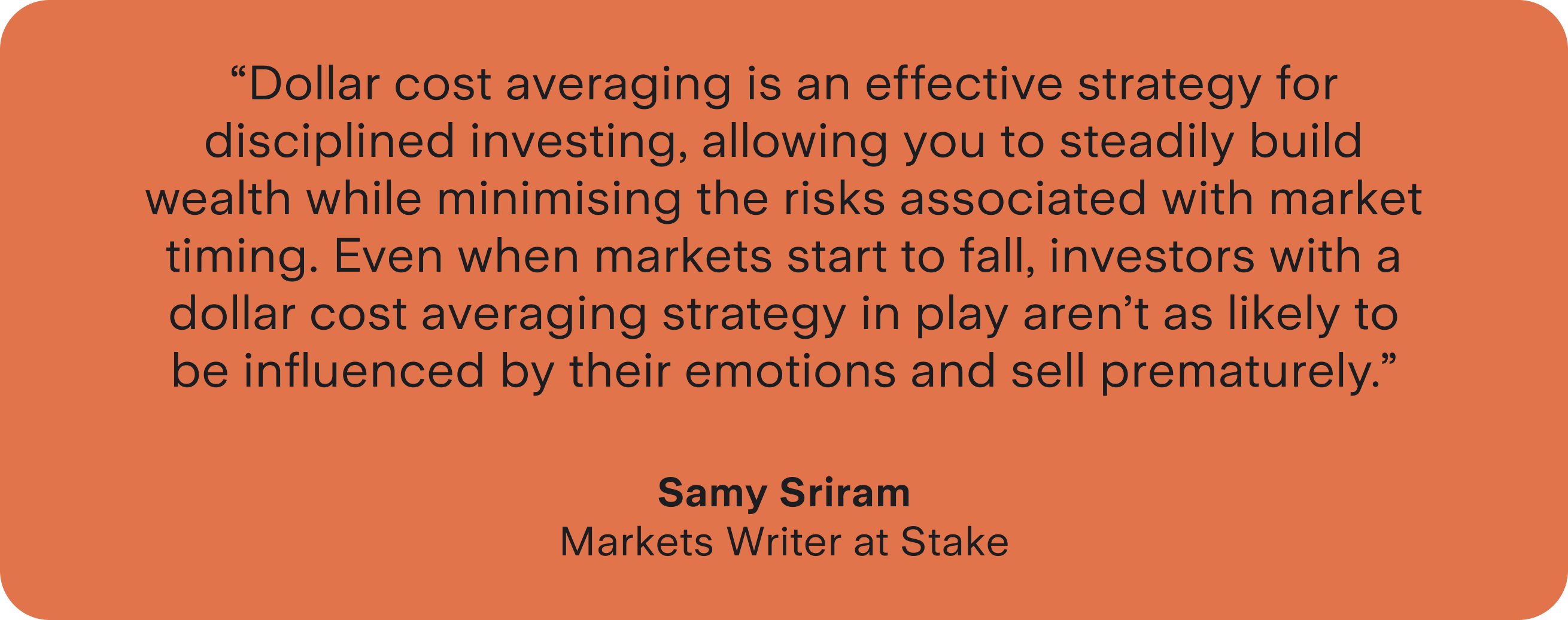
Guide to Dollar Cost Averaging [2024]
Before you start investing, you should consider what your investment strategy will be. There are plenty of strategies to choose from, and dollar cost averaging is but one example of a strategy that looks to minimise risk by making fixed recurring investments.
Buying stocks can be stressful, particularly if you are trying to time the market. Buy too soon and you risk regret when the price drops. But if you wait and the price goes up, you'll feel like you missed out.
If your investing strategy is to buy the same amount of stocks regularly then congratulations, you are already dollar cost averaging. If you're not, then let us tell you how a DCA strategy works.
What is dollar cost averaging?
Dollar cost averaging is also known as the constant dollar plan. This is because it's the practice of systematically investing equal amounts of money at regular intervals, regardless of the stock prices. This can reduce the overall impact of price volatility and lower the average purchase price per share.
The aim of a dollar cost averaging strategy is to prevent a poorly timed lump sum payment at a potentially higher price. It also eliminates the effort required to attempt to time the market to buy at the best prices.
How dollar cost averaging works?
Dollar cost averaging is a simple tool to build savings and wealth over the long term by making regular investments. By investing in smaller set amounts over a certain time period, you'll buy both when prices are low and high. This smooths out your average price.
It can be especially powerful in recessions and bear markets. Committing to a dollar cost averaging strategy means that you will be investing when the market or a stock is down, and that's when you can score the best deal and lower your average price.
🎓 Related: What is value investing?→
Dollar cost averaging example
See how investing a fixed amount of money at regular intervals using a DCA strategy can lead to the accumulation of shares over time at a better cost per share than an initial lump sum investment.
Dollar cost averaging strategy
Month | Investment Amount | Share Price | Shares Bought | Total Shares Owned | Total Invested |
|---|---|---|---|---|---|
January | $500 | $60 | 8.33 | 8.33 | $500 |
February | $500 | $45 | 11.11 | 19.44 | $1,000 |
March | $500 | $40 | 12.50 | 31.94 | $1,500 |
April | $500 | $45 | 11.11 | 43.05 | $2,000 |
May | $500 | $50 | 10.00 | 53.05 | $2,500 |
June | $500 | $52 | 9.62 | 62.67 | $3,000 |
- 62.67 shares accumulated from $3,000 invested
- Average cost per share $47.87
Lump sum investing strategy
Month | Investment Amount | Share Price | Shares Bought | Total Shares Owned | Total Invested |
|---|---|---|---|---|---|
January | $3000 | $60 | 50.00 | 50.00 | $3,000 |
- 50.00 shares accumulated from $3,000 invested
- Average cost per share $60
The dollar cost averaging strategy after their $3,000 investment accumulated 62.67 shares compared to the 50.00 shares from the lump sum investment. The DCA strategy also saw a much lower average cost per share price of $47.87 vs $60.
💡Related: Guide on Lump Sum Investing→
Advantages of dollar cost averaging
Find the core advantages of a DCA strategy below:
- Dollar cost averaging helps mitigate the risk of market volatility and the stress of finding the perfect time to invest. Instead of focusing on timing the market right, you set up a monthly investment at the same time.
- It encourages disciplined investing by removing much of the emotional decision-making typically associated with investing. This can prevent impulsive decisions based on short-term market movements.
- This strategy promotes disciplined saving and investing habits. It is particularly beneficial for new investors or those looking to build a consistent investing routine. It also allows investors to start with smaller amounts of money, making it accessible to a wider range of individuals. You don't need a large lump sum to begin investing.
- A ‘dynamic’ dollar cost averaging strategy adjusts the investment amount based on market conditions or other factors, rather than investing a fixed amount at regular intervals. This may be suitable for more seasoned investors looking to diversify their portfolios according to upcoming macroeconomic events.
- Dollar cost averaging can also be used for tax-loss harvesting. Investors sell losing assets to realise a tax deduction, and use the proceeds to invest in new assets. This strategy can help investors offset capital gains and reduce their tax liability.

Disadvantages of dollar cost averaging
- It's true that by dollar cost averaging, you may forgo gains that you otherwise would have earned if you had invested in a lump sum purchase and the stock rises. However, the success of a lump sum payment relies upon timing the market correctly. Market timing is something that is notoriously hard to do.
- Markets tend to go up over time. That means if you invest earlier, it's likely to do better than small amounts invested over a period of time.
- It's not a solution for all investment risks. You still have to identify a good investment and do your own research. If you choose a bad pick, then over time you will just be investing steadily into a losing investment.
- A passive approach also means you are not responding to changing environments. So you may want to think about incorporating a way to respond to the markets into any investment strategy.
Which type of investor should use dollar cost averaging?
Dollar cost averaging is a good strategy for investors with lower risk tolerance since choosing a lump sum investing strategy in the markets means you could run the risk of buying at a peak. Dollar cost averaging means you can avoid market timing and share price fluctuations. It can also help you to avoid short term volatility in the markets.
Dollar cost averaging FAQs
What is the difference between dollar cost averaging and value averaging?
The difference between dollar cost averaging and value averaging is that when you DCA into a stock, you are investing equal amounts of money at regular intervals, regardless of the price of the stock. When you are using a value averaging strategy, you invest more when the share price falls, and invest less when the share price rises. Instead of investing a set amount each period, a value averaging strategy makes investments based on the total size of the portfolio.
Is DCA investing common in the stock market?
Dollar cost averaging is one of the more popular investment strategies among investors who want simplicity.
By investing regularly, investors can gain a better outcome with lower risk tolerance and it is geared towards the 'set and forget' investing mindset. So it is a very popular strategy for those in the stock market who are trying to average out their returns.
How often should you invest when DCA investing?
One of the issues with dollar cost averaging is determining the period over which to use the strategy.
Is it best suited as a near-term investment strategy or long-term?
Well, you should consider your own financial situation before making a decision on how to invest your money. Remember that past performance is no indicator of future performance.
But typically, if you are dispersing a large sum you may want to spread it over one or two years. Any longer and you may result in missing a general upswing in the markets as inflation chips away at the real value of the money.
In addition to purchasing shares at set intervals, if the stocks you are purchasing pay dividends as well then you can reinvest those using a Dividend Reinvestment Plan strategy.
Does dollar cost averaging work?
DCA'ing can help mitigate the impact of market volatility by spreading investments over time, potentially reducing the average cost per share. Historical data suggests that DCA can be effective, especially in fluctuating or declining markets, by avoiding the pitfalls of trying to time the market.
The success of this strategy largely depends on the asset's long-term performance and the consistency of the investment schedule. While DCA doesn't guarantee profits or protect against losses, it encourages disciplined investing and can be a valuable strategy for investors looking to build wealth steadily.
How often should you DCA into an asset?
The frequency of dollar cost averaging depends on individual financial goals, cash flow, and market conditions. Common intervals include monthly, bi-weekly, or even weekly investments. Monthly DCA aligns well with most people's budgeting cycles, such as receiving a salary, making it manageable and consistent.
More frequent contributions, like bi-weekly or weekly, can take advantage of market fluctuations more effectively, potentially lowering the average investment cost over time.
Increasing the frequency will require more disciplined cash flow management. Ultimately, the best frequency is one that fits seamlessly into your routine and sets you up to achieve your financial goals, ensuring regular contributions without causing financial strain.
This article was edited by Samy Sriram - Markets Writer at Stake.
The information contained above does not constitute financial product advice nor a recommendation to invest in any of the securities listed. Past performance is not a reliable indicator of future performance. When you invest, your capital is at risk. You should consider your own investment objectives, financial situation and particular needs. The value of your investments can go down as well as up and you may receive back less than your original investment. As always, do your own research and consider seeking appropriate financial advice before investing.
Any advice provided by Stake is of general nature only and does not take into account your specific circumstances. Trading and volume data from the Stake investing platform is for reference purposes only, the investment choices of others may not be appropriate for your needs and is not a reliable indicator of performance.
$3 brokerage fee only applies to trades up to $30k in value (USD for Wall St trades and AUD for ASX trades). Please refer to hellostake.com/pricing for other fees that are applicable.

Stella is a markets analyst and writer with almost a decade of investing experience. With a Masters in Accounting from the University of Sydney, she specialises in financial statement analysis and financial modelling. Previously, she worked as an equity analyst at Australian finance start-up, Simply Wall St, where she took charge of the market insights newsletter sent out to over a million subscribers. At Stake, Stella has been key to producing the weekly Wrap articles and social media content.

